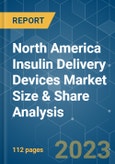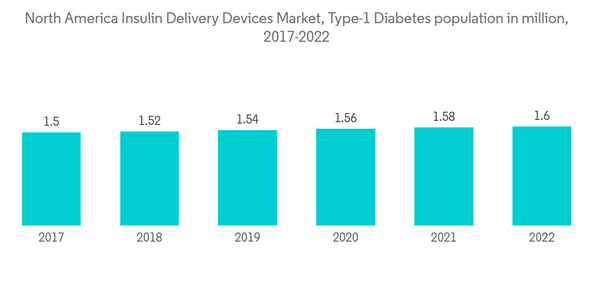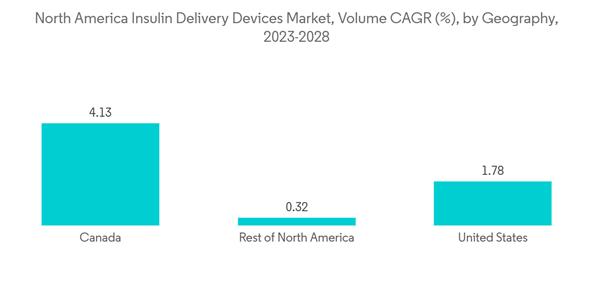The North America Insulin Delivery Devices Market size is expected to grow from USD 14.45 billion in 2023 to USD 18.49 billion by 2028, at a CAGR of 5.06% during the forecast period (2023-2028).
The COVID-19 pandemic has substantially impacted the North America Insulin Delivery Devices Market. Type-1 diabetes patients are impacted more during Covid-19. People with diabetes are having a weak immune system so, with COVID-19, the immune system gets weaker very fast. People with diabetes will have more chances to get into serious complications rather than normal people. The manufacturers of Insulin delivery devices have taken care during COVID-19 to deliver insulin delivery devices to diabetes patients with the help of local governments. Novo Nordisk stated on their website that “Since the start of COVID-19, our commitment to patients, our employees and the communities where we operate has remained unchanged, we continue to supply our medicines and devices to people living with diabetes and other serious chronic diseases, safeguard the health of our employees, and take actions to support doctors and nurses as they work to defeat COVID-19.” Doctors around the world suggested diabetes patients should check their diabetes levels more often to be careful and the intake of medicine has increased, which lead to an increase in the usage of insulin delivery devices.
In North America, till April 2022, the United States had the highest number of COVID cases with 82 million, the country also registered the highest death rate. According to the Diabetes Voice, close to 40,000 people who died were having diabetes. In the North American region diabetes patients were more concerned about stocking up the monitoring and managing devices due to this the market increased during these years.
Diabetes is associated with many health complications. Comparing the population with and without diabetes, those with diabetes have a 300% increased risk of being hospitalized and thus incur more healthcare expenses compared to non-diabetic people. Patients with Type 2 diabetes require many corrections throughout the day for maintaining nominal blood glucose levels, such as the administration of additional insulin or ingestion of additional carbohydrates. Furthermore, patients attempting to control their blood glucose levels tightly to prevent the long-term complications associated with fluctuations in blood glucose levels are at greater risk for overcorrection and the resultant hypoglycemia. Achieving nominal results can be very difficult without multiple daily injections of insulin or insulin pump therapy.
Therefore, owing to the aforementioned factors the studied market is anticipated to witness growth over the analysis period.
The CDC National Diabetes Statistics Report 2022 estimated that more than 130 million adults are living with diabetes or prediabetes in the United States. Type-2 diabetes is more common, and diabetes is more consequential among communities of color; those who live in rural areas; and those with less education, lower incomes, and lower health literacy.
According to Diabetes Canada, 2022 figures showed the continued rising trend of diabetes rates in Canada with no signs of leveling or decreasing. Diabetes continues to affect more Canadians than ever before. The new diabetes figures show a steady, continued increase in diabetes in the country with 11.7 million Canadians living with diabetes or prediabetes. More than 5.7 million Canadians are living with diagnosed diabetes and people living with diabetes or prediabetes which if left unmanaged, can develop into type-2 diabetes.
According to the Division of Metabolism and Endocrinology Products in the FDA’s Center for Drug Evaluation and Research, “Patients want effective treatment options for diabetes that are as minimally intrusive on their lives as possible, and the FDA welcomes the advancement of new therapeutic options that can make it easier for patients to control their condition”. The frequency of insulin administration varies from patient to patient. Type-1 diabetic patients need to check their blood glucose levels at regular intervals, monitor their blood glucose levels, and adjust the insulin dosing accordingly.
Therefore, owing to the rising diabetes prevalence the market studied is anticipated to witness growth over the analysis period.
An estimated 1.4 million Americans are diagnosed with diabetes every year, according to the American Diabetes Association. Diabetes is one of the leading causes of death in Canada and other North American countries. The growing incidence, prevalence, and progressive nature of the disease have encouraged treatment options for diabetic patients. The ADA also helps with costs for insulin and diabetes medication. Medicare drug plans cover insulin not used in an insulin pump and other drugs necessary to treat diabetes. In addition to providing prescription drug coverage, Medicare Part D plans may cover supplies necessary to inject insulin, including syringes, needles, alcohol swabs, and gauze.
The World Health Assembly Resolution 2022 recommended the integration of prevention and treatment of diabetes into primary health services, the development of pathways for a substantial increase in access to insulin, the promotion of convergence and harmonization of regulatory requirements for diabetes medicines and technologies, and improved diabetes monitoring and surveillance. Furthermore, it involves the WHO advising the Member States to ensure the uninterrupted treatment of people living with diabetes in humanitarian emergencies. This important milestone provides a global mandate for diabetes efforts for the next decade.
The roll-out of many new products, increasing international research collaborations in technological advancement, and increasing awareness about diabetes among people are expected to drive the market.
The COVID-19 pandemic has substantially impacted the North America Insulin Delivery Devices Market. Type-1 diabetes patients are impacted more during Covid-19. People with diabetes are having a weak immune system so, with COVID-19, the immune system gets weaker very fast. People with diabetes will have more chances to get into serious complications rather than normal people. The manufacturers of Insulin delivery devices have taken care during COVID-19 to deliver insulin delivery devices to diabetes patients with the help of local governments. Novo Nordisk stated on their website that “Since the start of COVID-19, our commitment to patients, our employees and the communities where we operate has remained unchanged, we continue to supply our medicines and devices to people living with diabetes and other serious chronic diseases, safeguard the health of our employees, and take actions to support doctors and nurses as they work to defeat COVID-19.” Doctors around the world suggested diabetes patients should check their diabetes levels more often to be careful and the intake of medicine has increased, which lead to an increase in the usage of insulin delivery devices.
In North America, till April 2022, the United States had the highest number of COVID cases with 82 million, the country also registered the highest death rate. According to the Diabetes Voice, close to 40,000 people who died were having diabetes. In the North American region diabetes patients were more concerned about stocking up the monitoring and managing devices due to this the market increased during these years.
Diabetes is associated with many health complications. Comparing the population with and without diabetes, those with diabetes have a 300% increased risk of being hospitalized and thus incur more healthcare expenses compared to non-diabetic people. Patients with Type 2 diabetes require many corrections throughout the day for maintaining nominal blood glucose levels, such as the administration of additional insulin or ingestion of additional carbohydrates. Furthermore, patients attempting to control their blood glucose levels tightly to prevent the long-term complications associated with fluctuations in blood glucose levels are at greater risk for overcorrection and the resultant hypoglycemia. Achieving nominal results can be very difficult without multiple daily injections of insulin or insulin pump therapy.
Therefore, owing to the aforementioned factors the studied market is anticipated to witness growth over the analysis period.
North America Insulin Delivery Devices Market Trends
Rising diabetes prevalence
The diabetes population in the North American region is expected to rise by more than 1% over the forecast period.The CDC National Diabetes Statistics Report 2022 estimated that more than 130 million adults are living with diabetes or prediabetes in the United States. Type-2 diabetes is more common, and diabetes is more consequential among communities of color; those who live in rural areas; and those with less education, lower incomes, and lower health literacy.
According to Diabetes Canada, 2022 figures showed the continued rising trend of diabetes rates in Canada with no signs of leveling or decreasing. Diabetes continues to affect more Canadians than ever before. The new diabetes figures show a steady, continued increase in diabetes in the country with 11.7 million Canadians living with diabetes or prediabetes. More than 5.7 million Canadians are living with diagnosed diabetes and people living with diabetes or prediabetes which if left unmanaged, can develop into type-2 diabetes.
According to the Division of Metabolism and Endocrinology Products in the FDA’s Center for Drug Evaluation and Research, “Patients want effective treatment options for diabetes that are as minimally intrusive on their lives as possible, and the FDA welcomes the advancement of new therapeutic options that can make it easier for patients to control their condition”. The frequency of insulin administration varies from patient to patient. Type-1 diabetic patients need to check their blood glucose levels at regular intervals, monitor their blood glucose levels, and adjust the insulin dosing accordingly.
Therefore, owing to the rising diabetes prevalence the market studied is anticipated to witness growth over the analysis period.
The United States holds the highest market share in the North America Insulin Delivery Devices Market in the current year
The United States holds the highest market share in the North American Insulin Delivery Devices Market in the current year and is expected to register a CAGR of about 5.2% over the forecast period.An estimated 1.4 million Americans are diagnosed with diabetes every year, according to the American Diabetes Association. Diabetes is one of the leading causes of death in Canada and other North American countries. The growing incidence, prevalence, and progressive nature of the disease have encouraged treatment options for diabetic patients. The ADA also helps with costs for insulin and diabetes medication. Medicare drug plans cover insulin not used in an insulin pump and other drugs necessary to treat diabetes. In addition to providing prescription drug coverage, Medicare Part D plans may cover supplies necessary to inject insulin, including syringes, needles, alcohol swabs, and gauze.
The World Health Assembly Resolution 2022 recommended the integration of prevention and treatment of diabetes into primary health services, the development of pathways for a substantial increase in access to insulin, the promotion of convergence and harmonization of regulatory requirements for diabetes medicines and technologies, and improved diabetes monitoring and surveillance. Furthermore, it involves the WHO advising the Member States to ensure the uninterrupted treatment of people living with diabetes in humanitarian emergencies. This important milestone provides a global mandate for diabetes efforts for the next decade.
The roll-out of many new products, increasing international research collaborations in technological advancement, and increasing awareness about diabetes among people are expected to drive the market.
North America Insulin Delivery Devices Industry Overview
The North American insulin delivery devices market is moderately consolidated due to the presence of major players such as Novo Nordisk, Sanofi, Eli Lilly and Company, Medtronic, Insulet, Ypsomped, Becton Dickinson and Company, etc. operating globally and other regional players.Additional Benefits:
- The market estimate (ME) sheet in Excel format
- 3 months of analyst support
Table of Contents
1 INTRODUCTION
4 MARKET DYNAMICS
5 MARKET SEGMENTATION
6 MARKET INDICATORS
7 COMPETITIVE LANDSCAPE
Companies Mentioned (Partial List)
A selection of companies mentioned in this report includes, but is not limited to:
- Novo Nordisk AS
- Sanofi
- Eli Lilly and Company
- Medtronic PLC
- Insulet Corporation
- Ypsomed
- Becton Dickinson and Company
Methodology

LOADING...










